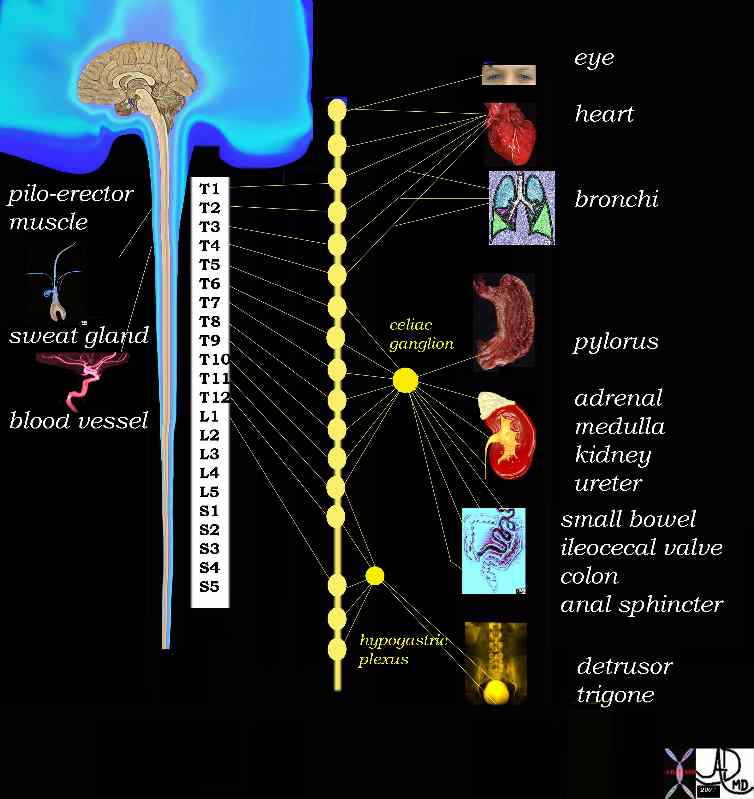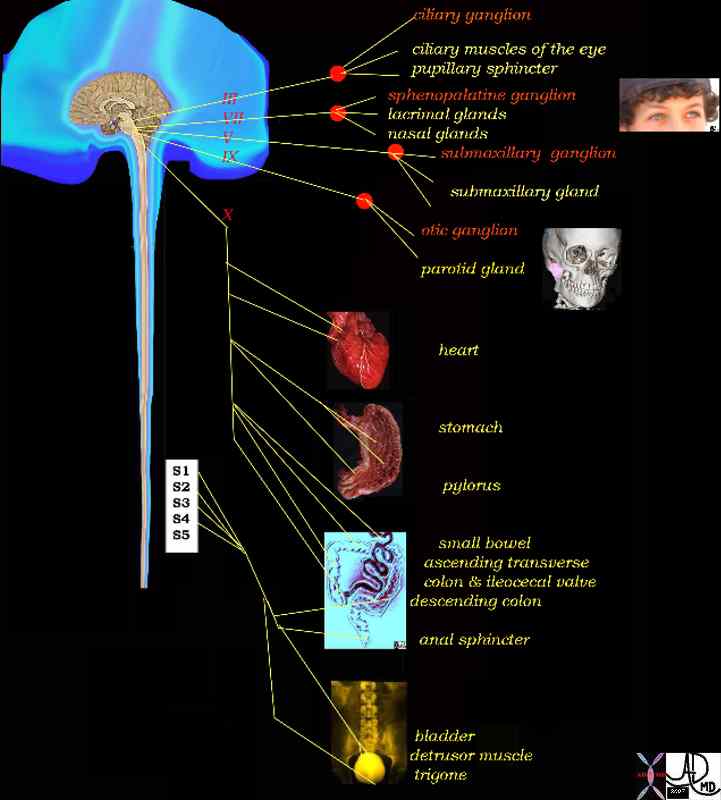| Nerve Supply
The Common Vein Copyright 2007 Autonomic Nervous System Control of the colonic function is a beautifully coordinated process. It is truly like a factory pipeline with activities of intake, processing, packaging, storage and transport an efficient and coordinated process. Events that are happening upstream in the stomach for example are sent by a messenger hormone gastrin, to get things going downstream by causing the ileocecal valve to open and allow emptying of the small bowel into the large in order to provide space for the new load of food. Peristaltic movements result in contraction in one palace in the bowel with receptive relaxation in another. The nervous system with some help from the hormonal system, are the machines that are working quietly in the background connecting and controlling the processes. There are local control systems as well as systemic control systems. In the systemic systems the basic mechanism consists of a sensory system which senses and perceives the milieu in the bowel, and then sends signals via the afferent nerves to the spinal cord and the brain. The efferent nerves bring the signals back to the bowel of what has to be done, and neuromuscular endings carry out the orders by causing contraction or relaxation of muscles. The sensors in the bowel wall are receptive to both chemical and mechanical stimuli. They are not able to sense temperature and pain from a pinprick for example, though excessive pressure does induce a painful sensation. The sensors that are responsible for identifying the local chemical milieu are thought to be located in the submucosa and are otherwise known as Meissner’s plexus, while those that sense pressure and other mechanical stimuli are found in the smooth muscle, and are known as Auerbach’s plexus. (Sykes) (Kamm) The autonomic nervous system is an involuntary system which is responsible for the minute to minute as well as the day to day functions of the colon. It consists of a parasympathetic system and a sympathetic system. In general the parasympathetic system in the gastrointestinal tract gets things moving by increasing peristalsis and opening valves and sphincters, and increasing blood flow to the digestive organs. In essence it promotes digestion and absorption, which is best done while the person is resting. The sympathetic system is the “fight or flight” component, and directs energy and blood to skeletal muscle and other organs that need energy when a person is active, and in turn directs energies away from the gastrointestinal tract. Thus in the digestive system, it slows things down by slowing peristalsis, closing valves and sphincters, and decreasing blood flow to the digestive tract. The nerves for the colon run with the arteries for the colon so that they travel with the superior mesenteric artery, inferior mesenteric artery, and internal iliac arteries. The plexuses and ganglia are halfway houses that receive afferent nerves from the bowel and efferent nerves from the spinal cord. They are located around the blood vessels and are named celiac, superior mesenteric, and inferior mesenteric ganglia, and superior and inferior hypogastric plexuses.
The controlling central organs for the autonomic nervous system is in the brain are within the medulla, pons and hypothalamus. The afferent system carries the signals from the colon to the spinal cord and brain, while the efferent nerves carry the signals from the brain and spinal cord back to the colon. The afferent system for the sympathetic and parasympathetic nerves lies within the splanchnic nerves that run with the arteries of the bowel. The parasympathetic efferent system runs in the vagus nerve along the SMA controlling the right side of the colon and along the iliac arteries in the pelvic splanchnic nerves for the left side of the colon. The nerves that carry efferent sympathetic function run with the splanchnic nerves alongside the SMA (thoracic splanchnic nerve) IMA (lumbar splanchnic nerve) and internal iliac artery as nerves derived from sacral segments 2,3 and 4 called the pelvic splanchnic nerves.The voluntary nervous system that controls the external sphincter and levator ani muscles consists of the pudendal and inferior hemorrhoidal nerve that enable relaxation of these muscles. |

 Sympathetic Efferent System
Sympathetic Efferent System Parasympathetic Efferents
Parasympathetic Efferents